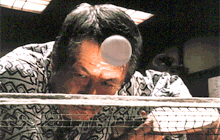 |
 |
 |
 |
 |
 |
|||||
 |
 |
 |
 |
| ON THE REBOUND: Table Tennis Enjoying a Resurgence in Popularity June 5, 2000
Japan has not produced any world-class table-tennis players since the era spanning the 1950s, 1960s, and 1970s. Since then Ping-Pong has been shunned by young people and relegated to the status of a minor sport. Recently, though, table tennis has been enjoying a resurgence in popularity. In trendy spots of Tokyo like Shibuya, it has become fashionable to go for a casual game after work or an evening of drinking. Shibuya the Focus of Ping-Pong Revival On weekdays table rentals cost 600 yen (5.70 U.S. dollars at 105 yen to the dollar) for 30 minutes, or 700 yen (6.70 dollars) after 6 p.m. The club is open until 4 a.m., and there is no charge for use of racquets and balls. This affordability makes Ping-Pong an ideal way to while away some time while working up a little sweat. In addition to businessmen, players also include Shibuya's famous ganguro gyaru (dark-tanned teenage girls with loud makeup), who chase after balls clad in their stilt-like, thick-soled boots. Variations on Ping-Pong What is behind this sudden table-tennis boom? Some have cited a recent television commercial for beer featuring popular actors involved in a heated table-tennis game as the origin of the sport's resurgence. Others point out that, while during the bubble economy table tennis was dismissed as a "game for the poor," in today's recession-hit Japan the concept of "honest poverty" has taken root, and people are viewing table tennis in a new light as a fun and inexpensive form of leisure. The Changing Face of Table Tennis Anxious to change this situation, the association has begun experimenting with more colorful uniforms and changing the color of Ping-Pong tables from dark green to bright blue as ways of giving the sport an image make over. The International Table Tennis Federation has also been taking steps to enhance the game: Beginning in October 2000, the diameter of the official ball will be increased by two millimeters, which will supposedly lead to longer rallies. In keeping with the revival of the game in Japan, a Japanese athlete won a medal at the world table-tennis championships in March 2000 for the first time in 19 years. The possibility of holding a professional tournament in Japan is also being discussed. Could these be further signs of a table-tennis renaissance?  Copyright (c) 2000 Japan Information Network. Edited by Japan Echo Inc. based on domestic Japanese news sources. Articles presented here are offered for reference purposes and do not necessarily represent the policy or views of the Japanese Government. Copyright (c) 2000 Japan Information Network. Edited by Japan Echo Inc. based on domestic Japanese news sources. Articles presented here are offered for reference purposes and do not necessarily represent the policy or views of the Japanese Government.
|


